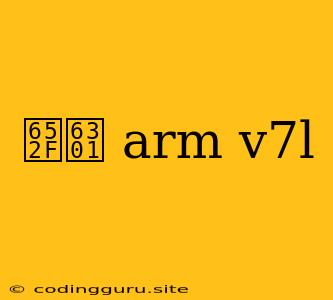Understanding ARM v7l Support: A Guide for Developers
In the world of software development, understanding processor architectures is crucial for optimizing performance and compatibility. One common architecture you might encounter is ARM v7l. This article aims to clarify what ARM v7l is, why it's important, and how it affects your development process.
What is ARM v7l?
ARM v7l refers to a specific variant of the ARM architecture designed for embedded systems and mobile devices. It stands for:
- ARM: Advanced RISC Machine - a family of instruction set architectures (ISAs) known for their efficiency and low power consumption.
- v7: The seventh major revision of the ARM architecture, introducing significant improvements over previous versions.
- l: Denotes a 32-bit architecture specifically designed for low-power devices.
Why is ARM v7l Important?
ARM v7l architecture is widely used in various devices, including:
- Smartphones and Tablets: Most mobile devices today use ARM v7l processors.
- Raspberry Pi: Popular single-board computers like the Raspberry Pi utilize ARM v7l for their processing power.
- IoT Devices: The low power consumption of ARM v7l makes it ideal for IoT applications.
- Embedded Systems: Many embedded systems, from industrial automation to automotive systems, rely on ARM v7l processors.
How Does ARM v7l Affect Development?
When developing applications or software, understanding ARM v7l compatibility is crucial:
- Cross-Compilation: If your target device uses ARM v7l, you need to cross-compile your code to create an executable file that runs on that specific architecture.
- Library Support: Not all libraries and software packages are compatible with ARM v7l. You need to ensure that the libraries you use have ARM v7l support.
- Performance Optimization: You can optimize your code for ARM v7l to improve performance and efficiency.
Tips for Working with ARM v7l
Here are some helpful tips for developers working with ARM v7l architectures:
- Choose the Right Toolchain: Utilize cross-compilers and build systems that support ARM v7l architectures.
- Test Thoroughly: Ensure your application works correctly on ARM v7l devices by testing on real hardware or emulators.
- Check Library Compatibility: Always verify that the libraries you use are compatible with ARM v7l.
- Optimize for Power Consumption: Implement techniques to minimize power consumption for better performance on mobile devices and IoT applications.
Examples of ARM v7l Processors
- Broadcom BCM2835: Used in the Raspberry Pi 1 and 2 models.
- Qualcomm Snapdragon 800 series: Popular in many Android smartphones.
- ARM Cortex-A7 and Cortex-A9: Commonly found in various embedded systems.
Conclusion
ARM v7l is a vital architecture for developers working on diverse devices and applications. By understanding its characteristics, compatibility requirements, and optimization strategies, you can build efficient and reliable software for a vast range of devices. Remember to choose the right tools, test thoroughly, and ensure library compatibility to ensure your projects work smoothly on ARM v7l architectures.
